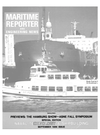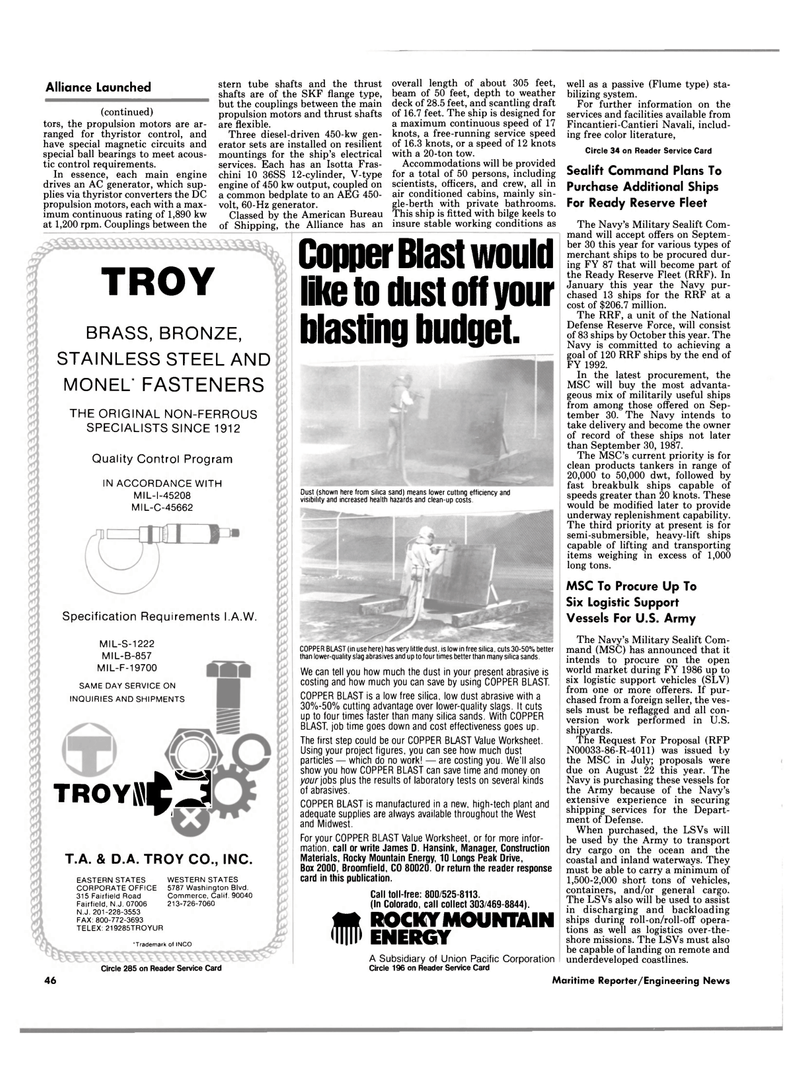
Page 44: of Maritime Reporter Magazine (September 1986)
Read this page in Pdf, Flash or Html5 edition of September 1986 Maritime Reporter Magazine
Alliance Launched (continued) tors, the propulsion motors are ar- ranged for thyristor control, and have special magnetic circuits and special ball bearings to meet acous- tic control requirements.
In essence, each main engine drives an AC generator, which sup- plies via thyristor converters the DC propulsion motors, each with a max- imum continuous rating of 1,890 kw at 1,200 rpm. Couplings between the stern tube shafts and the thrust shafts are of the SKF flange type, but the couplings between the main propulsion motors and thrust shafts are flexible.
Three diesel-driven 450-kw gen- erator sets are installed on resilient mountings for the ship's electrical services. Each has an Isotta Fras- chini 10 36SS 12-cylinder, V-type engine of 450 kw output, coupled on a common bedplate to an AEG 450- volt, 60-Hz generator.
Classed by the American Bureau of Shipping, the Alliance has an overall length of about 305 feet, beam of 50 feet, depth to weather deck of 28.5 feet, and scantling draft of 16.7 feet. The ship is designed for a maximum continuous speed of 17 knots, a free-running service speed of 16.3 knots, or a speed of 12 knots with a 20-ton tow.
Accommodations will be provided for a total of 50 persons, including scientists, officers, and crew, all in air conditioned cabins, mainly sin- gle-berth with private bathrooms.
This ship is fitted with bilge keels to insure stable working conditions as
TROY
BRASS, BRONZE,
STAINLESS STEEL AND
MONEL* FASTENERS
THE ORIGINAL NON-FERROUS
SPECIALISTS SINCE 1912
Quality Control Program
IN ACCORDANCE WITH
MIL-l-45208
MIL-C-45662
Specification Requirements I.A.W.
MIL-S-1222
MIL-B-857
MIL-F-19700
SAME DAY SERVICE ON
INQUIRIES AND SHIPMENTS
TROY^J
T.A. & D.A. TROY CO., INC.
EASTERN STATES
CORPORATE OFFICE 315 Fairfield Road
Fairfield, N.J. 07006
N.J. 201-228-3553
FAX: 800-772-3693
TELEX: 219285TROYUR
WESTERN STATES 5787 Washington Blvd.
Commerce, Calif. 90040 213-726-7060 •Trademark of INCO
Copper Blast would like to dust off your blasting budget.
Oust (shown here from silica sand) means lower cutting efficiency and visibility and increased health hazards and clean-up costs.
COPPER BLAST (in use here) has very little dust, is low in free silica, cuts 30-50% better than lower-quality slag abrasives and up to four times better than many silica sands.
We can tell you how much the dust in your present abrasive is costing and how much you can save by using COPPER BLAST.
COPPER BLAST is a low free silica, low dust abrasive with a 30%-50% cutting advantage over lower-quality slags. It cuts up to four times faster than many silica sands. With COPPER
BLAST, job time goes down and cost effectiveness goes up.
The first step could be our COPPER BLAST Value Worksheet.
Using your project figures, you can see how much dust particles — which do no work! — are costing you. We'll also show you how COPPER BLAST can save time and money on your jobs plus the results of laboratory tests on several kinds of abrasives.
COPPER BLAST is manufactured in a new, high-tech plant and adequate supplies are always available throughout the West and Midwest.
For your COPPER BLAST Value Worksheet, or for more infor- mation, call or write James D. Hansink, Manager, Construction
Materials, Rocky Mountain Energy, 10 Longs Peak Drive,
Box 2000, Broomfield, CO 80020. Or return the reader response card in this publication. ®
Call toll-free: 800/525-8113. (In Colorado, call collect 303/469-8844).
ROCKY MOUNTAIN ENERGY
Circle 285 on Reader Service Card
A Subsidiary of Union Pacific Corporation
Circle 196 on Reader Service Card well as a passive (Flume type) sta- bilizing system.
For further information on the services and facilities available from
Fincantieri-Cantieri Navali, includ- ing free color literature,
Circle 34 on Reader Service Card
Sealift Command Plans To
Purchase Additional Ships
For Ready Reserve Fleet
The Navy's Military Sealift Com- mand will accept offers on Septem- ber 30 this year for various types of merchant ships to be procured dur- ing FY 87 that will become part of the Ready Reserve Fleet (RRF). In
January this year the Navy pur- chased 13 ships for the RRF at a cost of $206.7 million.
The RRF, a unit of the National
Defense Reserve Force, will consist of 83 ships by October this year. The
Navy is committed to achieving a goal of 120 RRF ships by the end of
FY 1992.
In the latest procurement, the
MSC will buy the most advanta- geous mix of militarily useful ships from among those offered on Sep- tember 30. The Navy intends to take delivery and become the owner of record of these ships not later than September 30, 1987.
The MSC's current priority is for clean products tankers in range of 20,000 to 50,000 dwt, followed by fast breakbulk ships capable of speeds greater than 20 knots. These would be modified later to provide underway replenishment capability.
The third priority at present is for semi-submersible, heavy-lift ships capable of lifting and transporting items weighing in excess of 1,000 long tons.
MSC To Procure Up To
Six Logistic Support
Vessels For U.S. Army
The Navy's Military Sealift Com- mand (MSC) has announced that it intends to procure on the open world market during FY 1986 up to six logistic support vehicles (SLV) from one or more offerers. If pur- chased from a foreign seller, the ves- sels must be reflagged and all con- version work performed in U.S. shipyards.
The Request For Proposal (RFP
N00033-86-R-4011) was issued by the MSC in July; proposals were due on August 22 this year. The
Navy is purchasing these vessels for the Army because of the Navy's extensive experience in securing shipping services for the Depart- ment of Defense.
When purchased, the LSVs will be used by the Army to transport dry cargo on the ocean and the coastal and inland waterways. They must be able to carry a minimum of 1,500-2,000 short tons of vehicles, containers, and/or general cargo.
The LSVs also will be used to assist in discharging and backloading ships during roll-on/roll-off opera- tions as well as logistics over-the- shore missions. The LSVs must also be capable of landing on remote and underdeveloped coastlines. 46 Maritime Reporter/Engineering News

 43
43

 45
45
